38 Different Pride Flags and What Each Stands For
Inclusivity matters.


- Gilbert Baker Pride Flag
- 1978-1999 Pride Flag
- Traditional Gay Pride Flag
- Progress Pride Flag
- Intersex-Inclusive Progress Pride Flag
- Philadelphia People of Color-Inclusive Flag
- QPOC Flag
- Queer Pride Flag
- Bisexual Flag
- Pansexual Flag
- Asexual Flag
- Demisexual Flag
- Aromantic Flag
- Aroace Flag
- Lesbian Labrys Flag
- Lipstick Lesbian Flag
- Lesbian Flag
- Butch Lesbian Flag
- Polyamory Flag
- Polyamorous Pride Flag
- Intersex Flag
- Transgender Pride Flag
- Transgender Pride Flag
- Genderfluid/Genderflexible Flag
- Genderqueer Flag
- Leather, Latex, & BDSM Flag
- Bear Brotherhood Flag
- Twink Flag
- Rubber Pride Flag
- Polysexual Flag
- Agender Flag
- Nonbinary Flag
- Pony Flag
- Straight Ally Flag
- Two-Spirit Pride Flag
- Demigirl Flag
- Demiboy Flag
- Metagender Flag
- Celebrating Pride Month
With June as our official Pride Month in the United States, we typically see a wealth of in-person parades and events during this time (but different cities have celebrations at different times, so check to see what's local to you). As such, you'll likely see a lot of different Pride flags that embody different aspects of the LGBTQIA+ community. So what does each represent?
This list of Pride flags utilizes information from a range of sources, in particular The Advocate's comprehensive guide—but even outside of this article, there are many more iterations of Pride flags that exist, including flags from different countries and states; flags that include relevant symbols; and two or more flags combined into one. There's also some disagreement about what should be considered the "official" flags, and controversy about some of the flags' origins and meanings. But what's powerful is that the breadth of LGBTQIA+ representation continues to evolve, a nod to the vast diversity of sex, orientation, attraction, and gender.
Read on to learn more about Pride flags, their origins, and their meanings.
Gilbert Baker Pride Flag

In 1977, gay politician Harvey Milk tasked veteran Gilbert Baker to come up with a Pride flag. Milk said he felt that queer people "needed something that was positive, that celebrated our love." Inspired by Judy Garland's "Over the Rainbow," each color has symbolism: hot pink for sex, red for life, orange for healing, yellow for sunlight, green for nature, turquoise for magic/art, indigo for serenity, and violet for spirit.
1978-1999 Pride Flag

Milk was assassinated in 1978, and demand for the flag increased as people wanted to show their support. Apparently Baker had trouble getting the pink color, so the flag began selling with seven colors instead.
Traditional Gay Pride Flag

This is probably the flag you'll see most often: six colors are apparently easier to produce than the odd-numbered seven (although other reports say it was more about making the flag easier for parades and to hang on posts). The rainbow flag can operate as a general flag for the LGBTQIA+ community, but it's not necessarily all-inclusive. Many of the following flags (intersex, asexual, non-binary, etc.) embody different identities that exist within Q (queer) and/or outside this acronym.
Progress Pride Flag

This flag was designed to be a reboot of the original Pride flag taking inclusion even further, thanks to queer, nonbinary artist Daniel Quasar (xe/they). Their 2019 Kickstarter explained that xe aimed to put more emphasis on the design to deepen its meaning. Brown and black stripes represent people of color and people who have died from AIDS, while the white, pink, and blue (as you'll see later) are colors from the transgender flag.
Get exclusive access to fashion and beauty trends, hot-off-the-press celebrity news, and more.
Intersex-Inclusive Progress Pride Flag

One of the most modern iterations (and one of the most inclusive instances) of the Pride Flag is this, which was originally designed in 2021 by Valentino Vecchietti (she/her), an award-winning intersex artist from Intersex Equality Rights UK. The flag went viral and became a representation of "increasing LGBTI+ allyship and intersex visibility, representation and inclusion worldwide," per Vecchietti's website.
Philadelphia People of Color-Inclusive Flag

Philadelphia added brown and black at the top of their flag in 2017 to spotlight the importance of including queer people of color in the LGBTQIA+ community. If the design looks familiar to you, it's because Lena Waithe donned the colors as a cape at the Met Gala in 2018. "This epic moment of defiance was brought to you by Carolina Herrera," she wrote on Instagram.
QPOC Flag
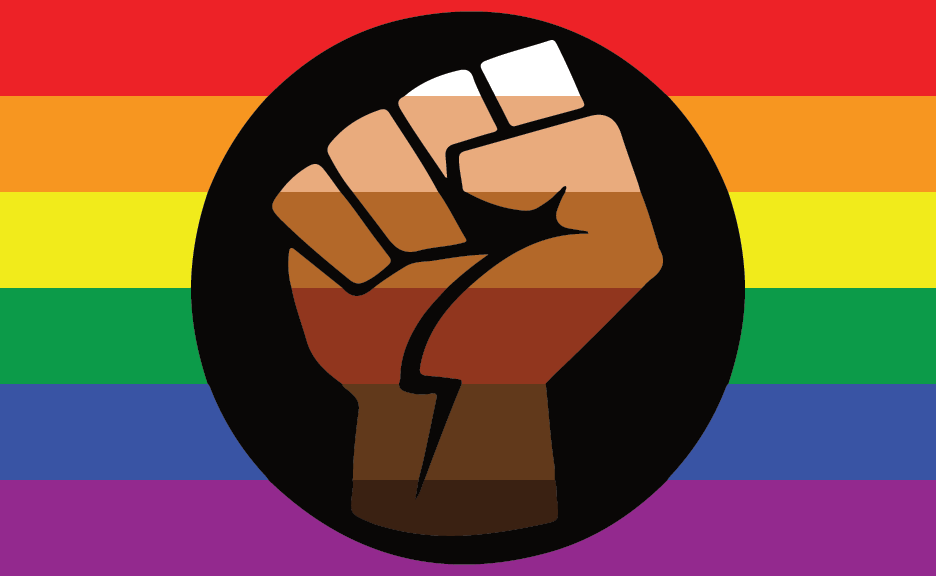
As a representation of Queer People of Color, it's not known who the original creator of the flag was but represents solidarity with the BLM movement as well as the intersection of the queer and Black communities (including the importance of figures like Marsha P. Johnson, the Black drag queen who may have thrown the first brick at the Stonewall Inn riots) to the movements. No surprise, the flag has become more popular in 2020 and beyond. The raised fist is a sign of unity and support as well as defiance and resistance, and the various colors on the fist represent diversity. Sometimes called the Resistance Flag, according to Them writer Matt Baume: "The modern LGBTQ+ liberation movement was touched off by queer and trans people of color and their struggle continues to this day, with both communities seeking justice, equality, and freedom from oppression. And because many people belong to both communities, they’re not two distinct causes but instead overlap."
Queer Pride Flag

An alternative of the traditional Pride flag, you might not see this one as much as you see some of the older, more established versions (this was created in 2015). Per the Human Rights Campaign, "the flag represents all aspects of queerness as the label ‘queer’ has become more celebrated." The significance is as follows: pink and blue for same-gender attraction, orange and green for non-binary and gender-non-conforming people, and black and white for asexual and aromantic people and people with an agender identity.
Bisexual Flag

In 1998, Michael Page wanted to spotlight bisexual people within the LGBTQIA+ community. Overlapping over the stereotypical colors for boys (blue) and girls (pink) is lavender—attraction to both sexes. Bisexuality doesn't necessarily just mean an attraction to two sexes, and there are other flags to represent attraction to more than one gender (as you'll see).
Pansexual Flag
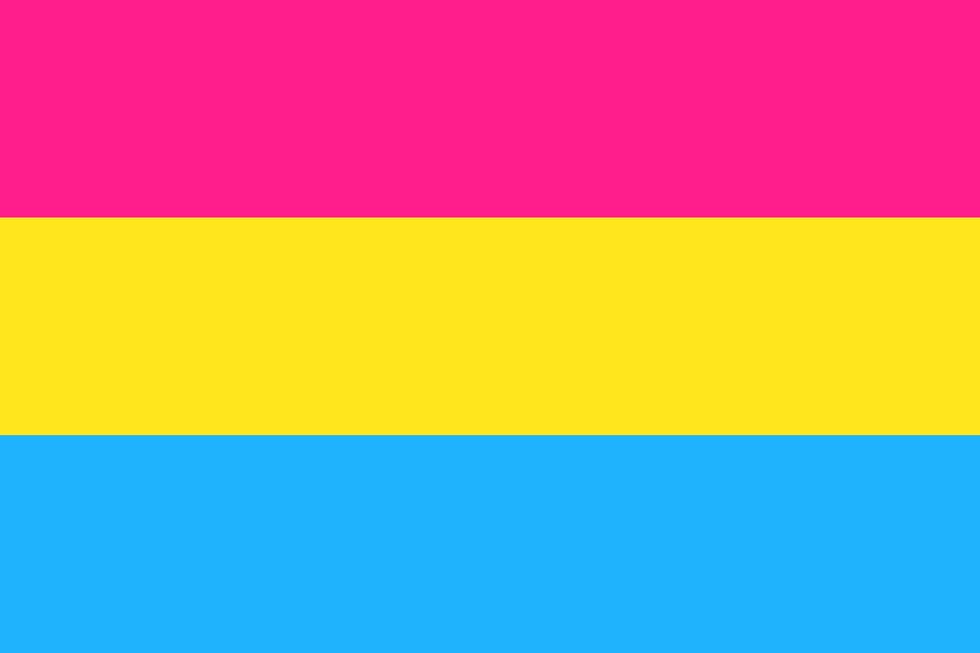
This flag, for example, represents pansexuality's interest in all genders: pink for women, blue for men, yellow for "nonbinary and gender-nonconforming people." It was created in 2010 to distinguish pansexuality from bisexuality.
Asexual Flag

In 2010, the Asexual Visibility and Education Network stated that they wanted to "have a symbol that belongs to all of us." The flag is inspired by their logo; black represents asexuality, gray for graysexuals (between sexual and asexual) and demisexual (sexual attraction following emotional connection). Purple represents community.
Demisexual Flag

The demisexual flag exists on the asexual spectrum, but also has its own separate flag (hence the similar colors in a different configuration). The term was coined in 2006 on The Asexual Visibility & Education Network (AVEN) by user “sonofzeal” but it's not known who designed the original flag.
Aromantic Flag

In a similar color scheme to the agender flag (more on that later), the green in the aromantic flag represents those living without romantic attraction or different romantic attraction. Gray and black are meant to represent all aromantic sexualities.
Aroace Flag

Tumblr user aroaesflags designed this flag in 2018 "with the experiences of aroaces who don’t split their attraction in mind." Aroace is short for aromantic and asexual, and the flag is designed to represent someone on both the asexual and aromantic spectrum. Blue is meant to represent a color between green and purple (from other, previous flags, like the ones above), white for wholeness, yellow for relationships existing outside conventional notions of romance, and orange for community.
Lesbian Labrys Flag

This flag isn't widely used—and part of the reason may be that the flag was designed in 1999 by a gay man, Sean Campbell. The Labrys is a double-sided axe apparently used by the Amazonians, and the black triangle was used by the Nazis to identify "antisocial" individuals.
Lipstick Lesbian Flag

Interestingly, this flag is also controversial—and now considered outdated in favor of a newer version (more on that in a minute). This one was designed by Natalie McCray in 2010 to celebrate lesbian femmes but isn't necessarily loved for its lack of inclusivity.
Lesbian Flag

The newer flag (created in 2018) doesn't have the lips and added more colors to celebrate (from the top) gender non-conformity, independence, community, unique relationships to womanhood, serenity and peace, love and sex, and femininity.
Butch Lesbian Flag

This is a more recent flag for "butch lesbians" (and is one of two variations): it represents female-identifying people who like female-identifying people and also present more "masculine" in appearance. Per The Advocate, this was originally designed by Tumblr user dorian-rutherford in 2016. That original post was deleted but it is presumed that the purple represents lesbians and female-identifying people, the white for people across gender, and the blue for masculinity.
Polyamory Flag

Just as the symbol pi goes on indefinitely after the decimal, there are infinite partners available to those who identify as polyamorous. Gold represents emotional connection, not just sexual love. A modified version was created in 2017 with infinity hearts instead of the pi symbol.
Polyamorous Pride Flag

More recently, over 30,000 polyamorous people voted on a new flag, and this version by Red Howell was the winner. The heart represents that "love in all forms is the core of non-monogamy." White represents possibility; magenta for desire, love, and attraction; blue for openness and honesty; gold for energy and perseverance; and purple for a united community.
Intersex Flag

Intersex International Australia designed this flag in 2013 with non-gendered colors "that celebrate living outside the binary." Intersex (variation in sex characteristics) is also represented in the transgender flag.
Transgender Pride Flag
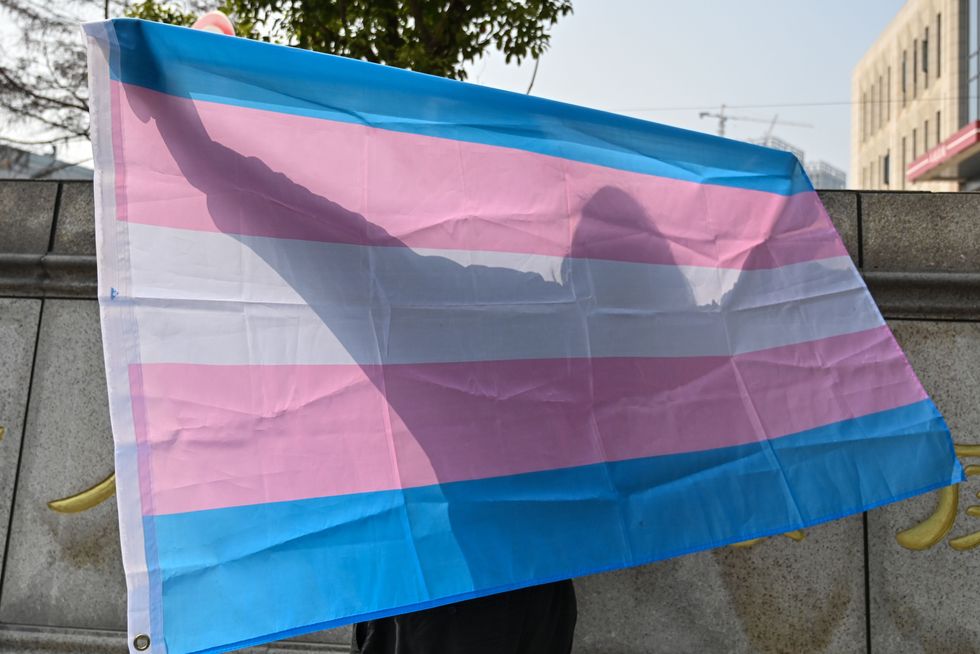
Those who are transitioning or have neutral/no gender are also included in the white on this flag. Trans woman Monica Helms designed this in 1999. The blue and pink represent colors traditionally representing boys and girls, respectively, and no matter which way you hold it, the flag is always right-side up.
Transgender Pride Flag

Another variation on the flag is to include a symbol to represent transgender people (female (♀), male (♂) and genderqueer (⚨) in a single circle) transposed on top of the five stripes.
Genderfluid/Genderflexible Flag

This flag was designed to embody all that genderfluidity can contain (since their gender can vary over time): Pink for femininity, blue for masculinity, white for no gender, black for all genders, and purple for the combination between masculine and feminine. JJ Poole created the flag in 2012.
Genderqueer Flag

Marilyn Roxie designed the genderqueer flag to represent those identifying outside the gender binary: lavender is androgeny, white is agender, and green is nonbinary. This is also known as the "nonbinary" flag.
Leather, Latex, & BDSM Flag
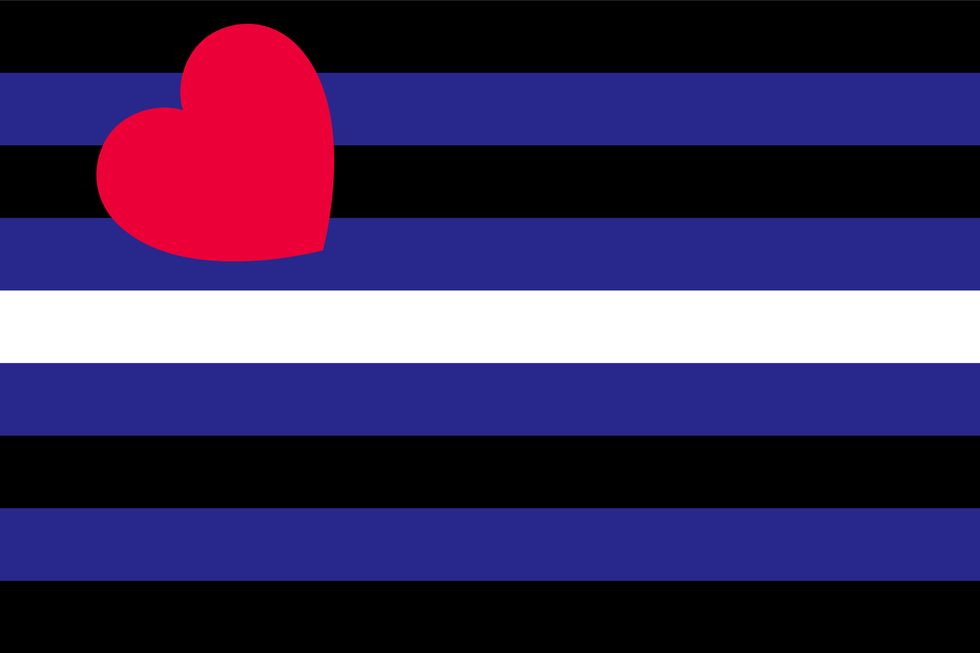
There's also debate over this flag, centered around whether kinks exist within or outside of the LGBTQIA+ community. But the "leather flag," created by Tony DeBlase in 1989, is a symbol of that community (which includes many gay men)—black to symbolize leather, white for purity, blue for devotion, and the heart for love.
Bear Brotherhood Flag

Craig Byrnes and Paul Witzkoske in 1995 made the "bear flag" for "a subculture of masculine-presenting gay, bisexual and trans men who embrace facial and body hair and may have larger bodies." Each stripe represents the different colors of bears.
Twink Flag

Another subculture flag, the "twink flag" is designed to represent "a young man (teens to early 20s) or one who looks younger than their age, who is typically attractive, lacking in body or facial hair and of a slim build." The meaning behind the colors isn't verified (the pink may be a celebration of the feminine) but the two intersecting Mars signs represents gay men.
Rubber Pride Flag

Members of the rubber/latex fetish community have a flag to express their preferences and passion. Peter Tolos and Scott Moats created it in 1995 and say that black represents "our lust for the look and feel for shiny black rubber," red "our blood passion for rubber and rubbermen," and yellow "our drive for intense rubber play and fantasies." Also, there's a kink in it—which totally makes sense, actually.
Polysexual Flag

Polysexual (attracted to multiple but not all genders, unlike pansexual) is still similar to the pansexual flag, with green representing nonconforming genders and pink and blue female and male, respectively. Polysexuality can sometimes be expressed as attraction to masculinity/femininity, not gender. The flag was created on Tumblr in 2012.
Agender Flag

Designer Salem X or "Ska" created a reversible flag—much like the transgender flag—to represent rejection of gender. Green is nonbinary, and black and white are absence of gender.
Nonbinary Flag

To add to the genderqueer flag's representation, 17-year-old Kye Rowan created the nonbinary flag in 2014 for gender existing outside the binary (symbolized by the yellow). White is all genders, black is no gender, and purple is a mix of genders.
Pony Flag

Another fetish flag, the pony play flag was designed in 2007 by Carrie P., and includes black to express unity with the larger leather community.
Straight Ally Flag
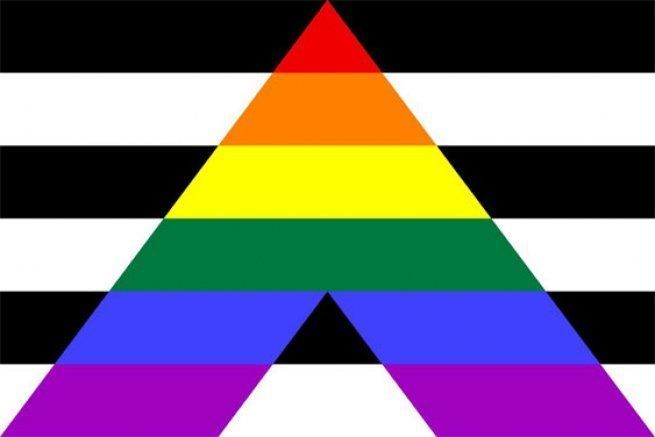
Sometimes known as the ally pride flag, this is a combination of different symbols—the straight flag is black and white stripes, the traditional pride flag is a rainbow—and the combination is meant to show allyship for the LGBTQIA+ community.
Two-Spirit Pride Flag

The Two-Spirit Pride Flag represents queer Native American individuals as an umbrella term, including traditional and cultural context. Per the University of Northern Colorado, "Two-spirit individuals traditionally were viewed as holding a masculine and feminine spirit. They held a gender identity outside of the binary man or woman." The flag's creation is attributed to Myra Laramee (Cree).
Demigirl Flag
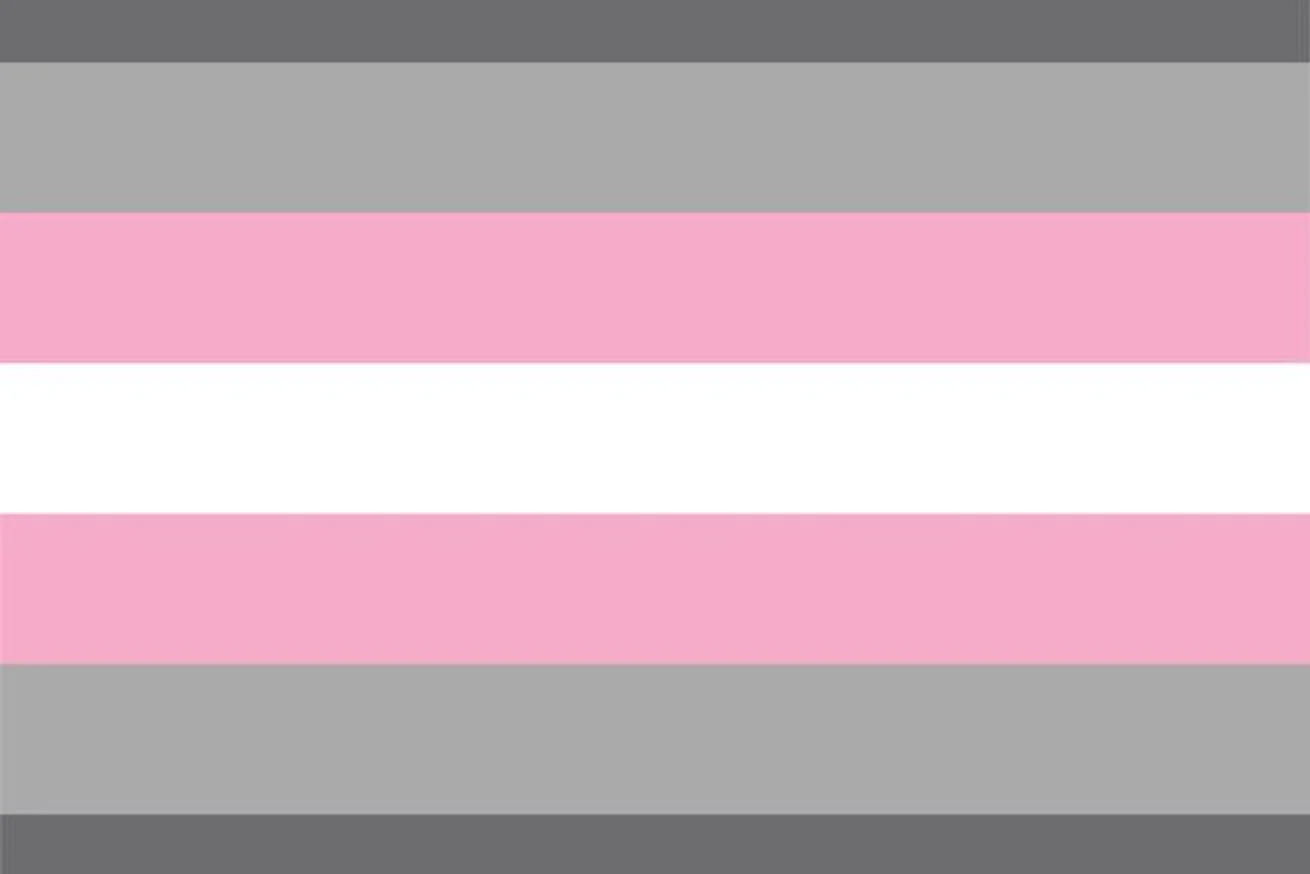
One of two flags designed by Tumblr user Transrants in 2015 to represent someone who's demigender (i.e., who has a partial but not full connection to a gender identity), this flag represents someone who partially identifies as a woman (a.k.a. "woman-adjacent").
Demiboy Flag

The other Transrants flag is designed to represent someone who partially identifies as a man. This is sometimes referred to as "man-adjacent."
Metagender Flag
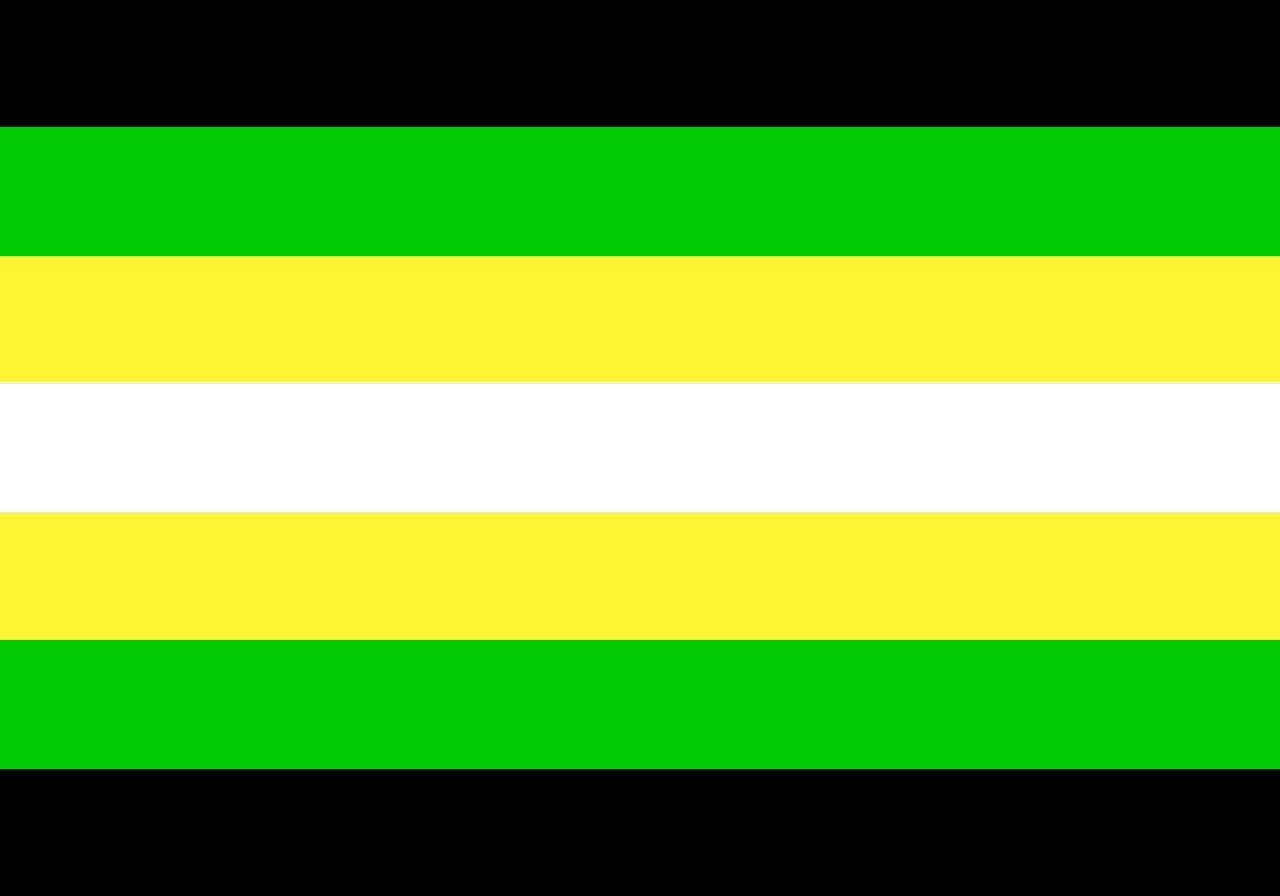
This flag is designed to hold space for people who don't consider themselves cisgender or transgender (whether agender, nonbinary, genderfluid, or identifying in some other way). According to Western Connecticut State University, "There is a varied set of reasons why individuals identify in this way, but there is a real linguistic need to describe this space." It is believed the first metagender flag was created by Tumblr user IMOGA-Pride.
Celebrating Pride Month

As the LGBTQIA+ movement continues to grow in awareness and inclusivity, we may see new flags and symbols. You have the freedom to choose the item you feel represents you. Pride is about appreciating diversity and honoring our past, present, and future. It's beautiful, no matter how you celebrate.

Katherine’s a contributing syndications editor at Marie Claire who covers fashion, culture, and lifestyle. In her role, she writes stories that are syndicated by MSN and other outlets. She’s been a full-time freelancer for over a decade and has had roles with Cosmopolitan (where she covered lifestyle, culture, and fashion SEO content) and Bustle (where she was their movies and culture writer). She has bylines in New York Times, Parents, InStyle, Refinery29, and elsewhere. Her work has also been syndicated by ELLE, Harper’s Bazaar, Seventeen, Good Housekeeping, and Women’s Health, among others. In addition to her stories reaching millions of readers, content she's written and edited has qualified for a Bell Ringer Award and received a Communicator Award.
Katherine has a BA in English and art history from the University of Notre Dame and an MA in art business from the Sotheby's Institute of Art (with a focus on marketing/communications). She covers a wide breadth of topics: she's written about how to find the very best petite jeans, how sustainable travel has found its footing on Instagram, and what it's like to be a professional advice-giver in the modern world. Her personal essays have run the gamut from learning to dress as a queer woman to navigating food allergies as a mom. She also has deep knowledge of SEO/EATT, affiliate revenue, commerce, and social media; she regularly edits the work of other writers. She speaks at writing-related events and podcasts about freelancing and journalism, mentors students and other new writers, and consults on coursework. Currently, Katherine lives in Boston with her husband and two kids, and you can follow her on Instagram. If you're wondering about her last name, it’s “I go to dinner,” not “Her huge ego,” but she responds to both.